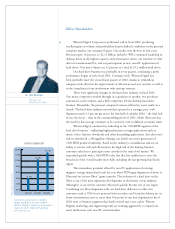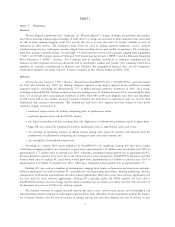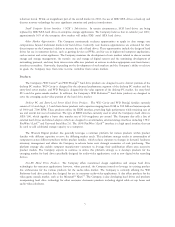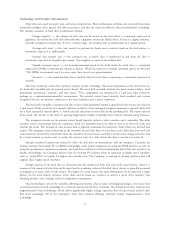Western Digital 2002 Annual Report Download - page 12
Download and view the complete annual report
Please find page 12 of the 2002 Western Digital annual report below. You can navigate through the pages in the report by either clicking on the pages listed below, or by using the keyword search tool below to find specific information within the annual report.Constant innovations in research and development are essential to the Company's ability to compete. Hard drive
providers are evaluating or implementing a number of technological innovations designed to further increase hard drive
performance and reduce product costs, including simplifying the electronic architecture by combining the traditional
controller, channel, microprocessor and servo-interface management functions of traditional hard drive microprocessors on
a single integrated circuit. Moreover, to consistently achieve timely introduction and rapid volume production of new
products, some hard drive providers, including the Company, are striving to simplify their product design processes by
focusing on creating extendible core technology platforms which utilize common Ñrmware and mechanical designs and
reuse of manufacturing tooling and application-speciÑc integrated circuits across various product generations and product
lines.
For an additional discussion of technological innovations, see Part II, Item 7, under the heading ""Risk factors
related to the hard drive industry in which we operate.''
Sales and Distribution
The Company sells its products globally to computer manufacturers, distributors, resellers, systems integrators and
retailers. Manufacturers typically purchase components such as hard drives and assemble them into the computer systems
they build. Distributors typically sell the Company's drives to small computer manufacturers, dealers, system integrators
and other resellers.
Manufacturers. Sales to manufacturers accounted for 54%, 48% and 55% of the Company's revenues in 2002,
2001 and 2000, respectively. During 2002, the Company's major computer manufacturer customers included Dell,
Fujitsu, Gateway, Hewlett-Packard, Microsoft, NEC and Trigem. Occasionally, revenues from sales to certain
manufacturers account for more than 10% of the Company's revenues in a particular year. For example, during 2002,
sales to Dell and Hewlett-Packard (including sales to Compaq Computer prior to its merger with Hewlett-Packard in
2002) accounted for 15% and 13% of revenues, respectively. During 2001, sales to Dell and Compaq Computer
accounted for 16% and 12% of revenues, respectively. During 2000, sales to Compaq Computer accounted for 21% of
revenues. The Company believes that its success depends on its ability to maintain and improve its strong relationships
with the leading computer manufacturers. Since 2000, Western Digital, Maxtor (which merged with Quantum in
2000) and Seagate have had the highest market share with these manufacturers.
In 2002, the top ten desktop personal computer manufacturers accounted for approximately 52% of all shipments in
the desktop PC market. As a result, maintaining customer satisfaction with these leading computer manufacturers is
critical.
Computer manufacturers evaluate and select their hard drive suppliers based on a number of factors, including
overall quality, storage capacities, performance characteristics, price, service and support, ease of doing business, and the
supplier's long-term Ñnancial stability. They typically seek to qualify two or three providers for each generation of hard
drives, and once a computer manufacturer has chosen its qualiÑed hard drive vendors for a given product, it generally will
purchase hard drives from those vendors for the life of that product. To achieve success with computer manufacturers'
qualiÑcations, a hard drive supplier must consistently oÅer hard drives featuring leading technology, quality and high
capacity per disk. Suppliers must quickly achieve volume production of high quality and reliable hard drives. To quickly
achieve high volume production, a hard drive supplier must have access to Öexible, high-capacity, high-quality
manufacturing capabilities.
Many of the Company's computer manufacturer customers (also referred to as original equipment manufacturers or
""OEMs'') have adopted just-in-time inventory management processes or supply chain business models that combine
""build-to-order'' (computer manufacturer does not build until there is a Ñrm order) and ""contract manufacturing''
(computer manufacturer contracts assembly work to a contract manufacturer who purchases components and assembles
the computer based on the computer manufacturer's instructions). For certain key OEMs the Company maintains a base
stock of several weeks, on average, of current, Ñnished goods inventory in facilities located adjacent to the OEM's
operations. Inventory at these locations usually includes minor product customizations (such as labeling) for the related
computer manufacturer. If subsequent to its initial order the computer manufacturer changes its requirements, inventory
held at these facilities can be sold to other computer manufacturers or distributors ""as is'' or with minor modiÑcations
(such as a change in labeling) at little or no additional cost. Therefore, changes in an OEM's requirements have minimal
impact on inventory valuation.
7
























